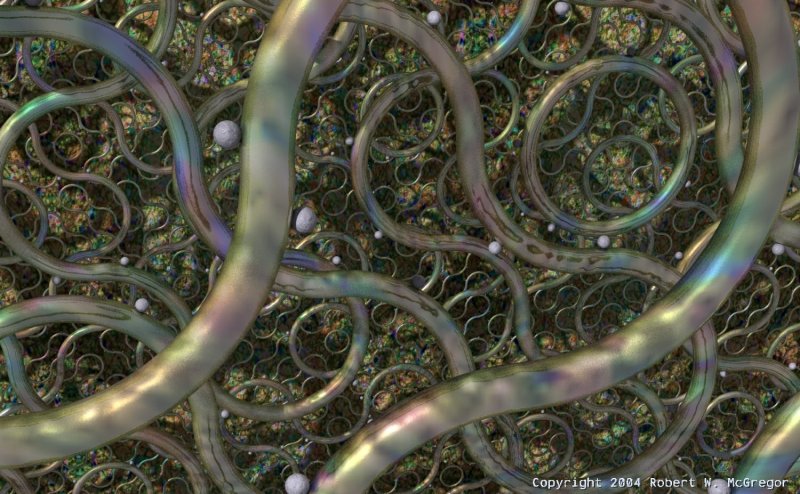Making Pathways
Composition
The main idea for this piece was to allow POVRay to generate the scene composition based on a few simple rules by using non-periodic tiling of cubes containing two 90 degree slices of a torus. In a macro I set up an XY grid of these cubes, each rotated randomly either 0 or 90 degrees on the Z-axis. This simple trick (derived from work by a 17th-century Dominican monk named Sebastian Truchet) yields an intricate pattern of infinitely non-repeating, non-intersecting tubes.
For some additional eye candy, a sphere is placed on the surface of each torus section within each cube in the cube array, and these spheres are randomly rotated along the torus surface to give a more natural flow to the overall composition.
Shapes
The tubes are made of two 90-degree torus slices, with one end of each sliced torus "elbow" touching the center of a different cube face (the cubes themselves are invisible), like this:
#declare Cube =
box { -0.5, 0.5 pigment { rgb 0.25 transmit 0.75} finish { Shiny }}
#declare Slice =
difference {
torus { 0.5, 0.05 }
object { Cube scale x*1.5 translate z*0.5 }
object { Cube scale z*1.5 translate x*0.5 }
}
#declare Tile = union {
//object { Cube }
object { Slice translate x*0.5 translate z*0.5 rotate z*90 rotate -y*90 }
object { Slice translate x*0.5 translate z*0.5 rotate z*90 rotate y*90 rotate x*180 }
}
Materials
The background plane is textured using an abstract and very colorful image map pigment with an averaged granite normal.
For the tubes I also used an averaged normal. I used the background image map as a bump map and averaged this with two unique layers of granite, each having a diferent bump size and scale, and a pseudo-fractalized normal_map for a hammered effect, like this:
#declare N_Hammered = normal {
bozo
normal_map {
[0.00 dents 0.05 scale 0.01]
[0.15 dents 0.05 scale 0.001]
[0.3 dents 300 scale 0.0005]
[0.45 dents 0.02 scale 0.01]
[0.5 bumps 0.07 scale 0.01]
[1.0 dents 0.05 scale 0.005]
}
}
#declare N_Tubes = normal {
bump_map {
png "ImageMap.png"
map_type 1
interpolate 2
bump_size 0.5
}
}
normal {
average
normal_map {
[ 1.5 N_Tubes ]
[ 0.1 granite 0.5 scale 0.2 ]
[ 0.1 granite 0.75 scale 0.12 ]
[ 0.5 N_Hammered scale 2 ]
}
}
For the tube pigment I again used the background image map. This reuse of the image map as both normal and pigment throughout the scene really ties everything together into a cohesive whole. The spheres use a similar texture.
The final touch is my use of the golden ratio for the image size, giving the overall composition a pleasing sense of classical proportion. The deep shadows cast from the multiple layers of tubes onto the background plane add a sense of mystery to their intricate, colorful, and delicately pleasing geometries.




